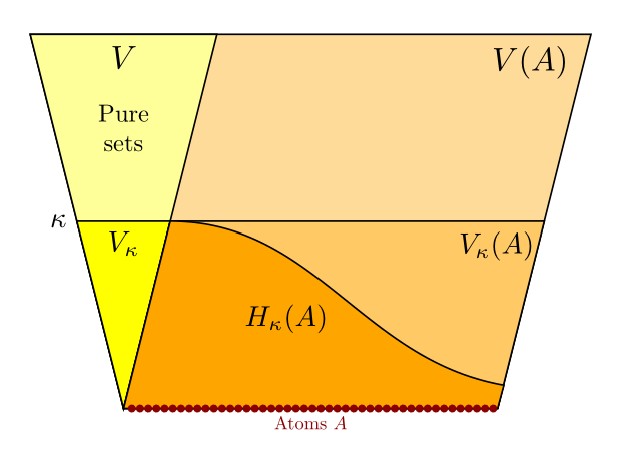Jason Aaron Schanker earned his Ph.D. under my supervision at the CUNY Graduate Center in June, 2011. Jason’s dissertation introduces several interesting new large cardinal notions, investigating their interaction with forcing, indestructibility, the Generalized Continuum Hypothesis and other topics. He defines that a cardinal $\kappa$ is weakly measurable, for example, if any family of $\kappa^+$ many subsets of $\kappa$ can be measured by a $\kappa$-complete filter. This is equivalent to measurability under the GCH, of course, but the notions are not equivalent in general, although they are equiconsistent. The weak measurability concept can be viewed as a generalization of weak compactness, and there are myriad equivalent formulations, including elementary embedding characterizations using transitive domains of size $\kappa^+$. It was known classically that the failure of the GCH at a measurable cardinal has consistency strength strictly greater than a measurable cardinal, but Jason proved that the corresponding fact is not true for the weakly measurable cardinals. Generalizing this notion, Jason introduced the near supercompactness hierarchy, which refines and extends the usual supercompactness hierarchy in a way that adapts well to many existing forcing arguments. Jason holds a faculty position at Manhattanville College in Purchase, New York.

Jason Schanker
web page | math genealogy | MathSciNet | google scholar | I-phone apps | related posts
Jason Schanker, “Weakly Measurable Cardinals and Partial Near Supercompactness,” Ph.D. dissertation for the Graduate Center of the City University of New York, June, 2011.
Abstract. I will introduce a few new large cardinal concepts. A weakly measurable cardinal is a new large cardinal concept obtained by weakening the familiar concept of a measurable cardinal. Specifically, a cardinal $\kappa$ is weakly measurable if for every collection $A$ containing at most $\kappa^+$ many subsets of $\kappa$, there exists a nonprincipal $\kappa$-complete filter on $\kappa$ measuring all sets in $A$. Every measurable cardinal is weakly measurable, but a weakly measurable cardinal need not be measurable. Moreover, while the GCH cannot fail first at a measurable cardinal, I will show that it can fail first at a weakly measurable cardinal. More generally, if $\kappa$ is measurable, then we can make its weak measurability indestructible by the forcing $\text{Add}(\kappa,\eta)$ for all $\eta$ while forcing the GCH to hold below $\kappa$. Nevertheless, I shall prove that weakly measurable v cardinals and measurable cardinals are equiconsistent.
A cardinal κ is nearly $\theta$-supercompact if for every $A\subset\theta$, there exists a transitive $M\models\text{ZFC}^-$ closed under ${<}\kappa$ sequences with $A,\kappa,\theta\in M$, a transitive $N$, and an elementary embedding $j : M \to N$ with critical point $\kappa$ such that $j(\kappa) > \theta$ and $j”\theta\in N$. This concept strictly refines the $\theta$-supercompactness hierarchy as every $\theta$-supercompact cardinal is nearly $\theta$-supercompact, and every nearly $2^{\theta^{{<}\kappa}}$-supercompact cardinal $\kappa$ is $\theta$-supercompact. Moreover, if $\kappa$ is a $\theta$-supercompact cardinal for some $\theta$ such that $\theta^{{<}\kappa}=\theta$, we can move to a forcing extension preserving all cardinals below $\theta^{++}$ where $\kappa$ remains $\theta$-supercompact but is not nearly $\theta^+$-supercompact. I will also show that if $\kappa$ is nearly $\theta$-supercompact for some $\theta\geq 2^\kappa$ such that $\theta^{{<}\theta}=\theta$, then there exists a forcing extension preserving all cardinals at or above $\kappa$ where $\kappa$ is nearly $\theta$-supercompact but not measurable. These types of large cardinals also come equipped with a nontrivial indestructibility result, and I will prove that if $\kappa$ is nearly $\theta$-supercompact for some $\theta\geq\kappa$ such that $\theta^{{<}\theta}=\theta$, then there is a forcing extension where its near $\theta$-supercompactness is preserved and indestructible by any further ${<}\kappa$-directed closed $\theta$-c.c. forcing of size at most $\theta$. Finally, these cardinals have high consistency strength. Specifically, I will show that if $\kappa$ is nearly $\theta$-supercompact for some $\theta\geq\kappa^+$ for which $\theta^{{<}\theta}=\theta$, then AD holds in $L(\mathbb{R})$. In particular, if $\kappa$ is nearly $\kappa^+$-supercompact and $2^\kappa=\kappa^+$, then AD holds in $L(\mathbb{R})$.





